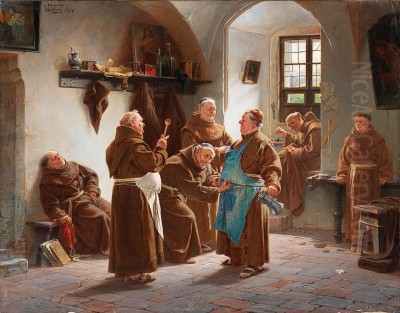
Adolf Humborg stands as a notable figure within the Austrian and German art scenes of the late nineteenth and early twentieth centuries. Born in 1847 and passing away in 1921, his life spanned a period of significant artistic transition, yet he remained largely dedicated to the traditions of academic realism and genre painting, finding a particular niche in depicting humorous and detailed scenes of monastic life. Though perhaps not as revolutionary as some of his contemporaries, Humborg carved out a successful career, creating works appreciated for their narrative charm, technical skill, and gentle humour.
Origins and Academic Formation
Adolf Humborg's journey began on January 17, 1847, in Oravica (also spelled Oravicza or Oravița), a town then part of the Kingdom of Hungary within the Austrian Empire, now located in Romania. This region, Banat, was known for its diverse population and cultural intersections, which may have subtly influenced the young Humborg's observational skills. Recognizing his artistic inclinations, he pursued formal training, a crucial step for any aspiring painter in that era.
His education took him to two major artistic centers of the Habsburg Empire and the German-speaking world: Vienna and Munich. He enrolled as a student at the Academy of Fine Arts Vienna (Akademie der bildenden Künste Wien). Vienna's Academy was a bastion of tradition, though figures like the immensely influential Hans Makart, known for his opulent historical paintings, dominated the scene during the latter half of the 19th century. Studying in Vienna would have exposed Humborg to the rigorous demands of academic drawing, composition, and the grand manner, even if his own path led towards more intimate genre subjects.
Following his time in Vienna, Humborg continued his studies at the Munich Academy of Fine Arts (Akademie der Bildenden Künste München). Munich, during the mid-to-late 19th century, was arguably the most important center for painting in Germany, rivaling even Paris in certain aspects, particularly in historical and genre painting. The Munich School was renowned for its emphasis on realism, painterly technique, and often, anecdotal or narrative subjects drawn from everyday life or history.
The Influence of the Munich School
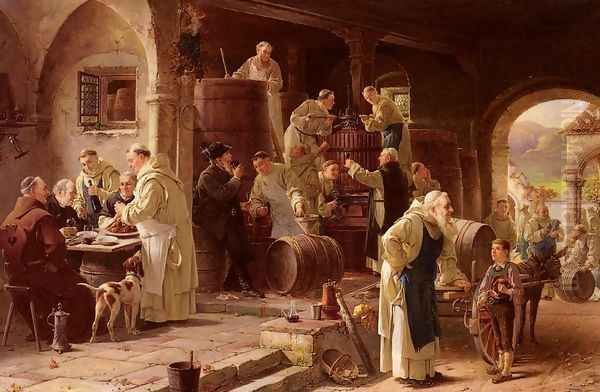
Studying in Munich placed Humborg directly within a vibrant and influential artistic milieu. The Academy boasted prominent teachers who shaped generations of artists. Figures like Karl von Piloty were famous for their large-scale historical dramas, emphasizing meticulous detail and theatrical staging. Others, such as Wilhelm von Diez, were known for their looser brushwork and focus on genre and animal painting, contributing to a more painterly realism.
The Munich School's emphasis on genre painting proved particularly formative for Humborg. This tradition, which had roots in earlier Biedermeier art as seen in the work of Viennese painters like Ferdinand Georg Waldmüller, found fertile ground in Munich. Artists specialized in depicting scenes of rural life, tavern interiors, historical anecdotes, and, significantly for Humborg, the lives of monks and clergy. This environment undoubtedly encouraged Humborg to develop his own specialization.
Munich provided not only training but also a market and a community. The city hosted major international art exhibitions, attracting artists and buyers from across Europe and America. Success in Munich could launch a career, and Humborg seems to have found his footing there, eventually settling in the city for a significant part of his working life, although some sources suggest a later move to Eisenach.
Chronicler of the Cloister
While Humborg painted various genre scenes, he became particularly renowned for his depictions of monastic life. His monks are rarely portrayed in moments of deep spiritual contemplation; instead, Humborg focused on the more mundane, human, and often humorous aspects of their existence within the cloister walls. These paintings often feature monks enjoying meals, sampling wine, engaging in quiet hobbies, or interacting with visitors, frequently with a gentle, anecdotal charm.
Works like Conciliabulum en réfectoire (likely meaning "A Meeting in the Refectory") exemplify this focus. Such scenes allowed Humborg to showcase his skill in rendering interiors, still life elements (food, wine bottles, tableware), and, most importantly, character expression. His monks are often depicted as jovial, slightly indulgent figures, their personalities conveyed through subtle gestures and facial expressions. The settings, typically cellars, refectories, or libraries, are rendered with careful attention to detail, creating a convincing and atmospheric backdrop.
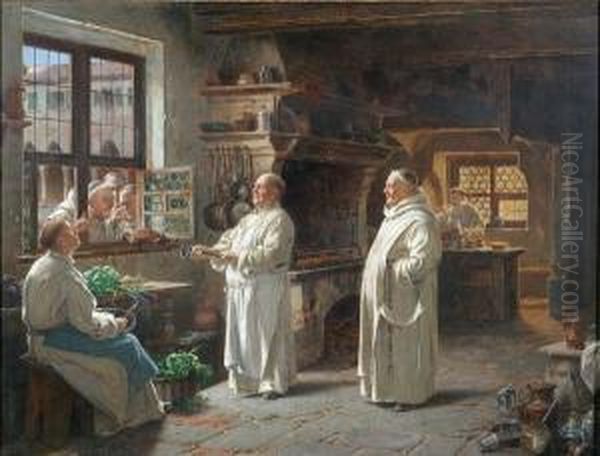
Another key work mentioned is Neuer Wein (New Wine). This title strongly suggests a scene set in a monastery cellar, perhaps showing monks eagerly or critically tasting the latest vintage. Wine, particularly its enjoyment, became a recurring motif in this subgenre, offering opportunities for humorous depictions of connoisseurship or simple pleasure. These themes resonated with a bourgeois audience who appreciated the blend of skillful painting, gentle humour, and the slightly romanticized, secluded world of the monastery.
Der Verspätete Abendessen (The Delayed Supper) is another representative title, hinting at a narrative element. One can imagine a scene involving a latecomer, perhaps a guest or a tardy monk, arriving to find the meal already underway or concluded. Such scenarios allowed Humborg to explore social interactions and create small, relatable dramas within the monastic setting.
In choosing this subject matter, Humborg was not alone. The Munich artist Eduard von Grützner built a highly successful career almost exclusively painting cheerful, wine-loving monks and clerics. While Humborg's work shares thematic similarities with Grützner's, each artist brought their own nuances to the popular genre. Humborg's approach often feels slightly quieter and perhaps more focused on detailed observation than Grützner's sometimes broader humour.
Broader Genre Painting
Beyond the monastery walls, Humborg applied his talents to other genre subjects, capturing scenes of everyday life that reflected the society of his time. Titles like Ein seltenes Gastes (A Rare Guest) and Ein Maler im bayerischen Wirthshaus (A Painter in a Bavarian Inn) indicate his interest in social settings and character studies outside the religious context.
The tavern scene, Ein Maler im bayerischen Wirthshaus, is particularly suggestive. It places an artist figure within a common social space, perhaps reflecting Humborg's own experiences or observations within the Munich art scene. Bavarian inns were popular subjects for Munich genre painters, offering rich opportunities to depict varied social types, rustic interiors, and moments of conviviality or contemplation. Such works connected with a broader tradition of genre painting exemplified by artists like Franz von Defregger, who specialized in scenes of Tyrolean peasant life, also popular among Munich collectors.
Humborg's skill extended to portraiture as well, as evidenced by works titled Male head. While genre scenes were his primary focus, the ability to capture a likeness and convey personality was fundamental to academic training and likely formed part of his output. His portraits probably shared the same commitment to realistic detail and careful execution seen in his narrative works.
Artistic Style and Technique
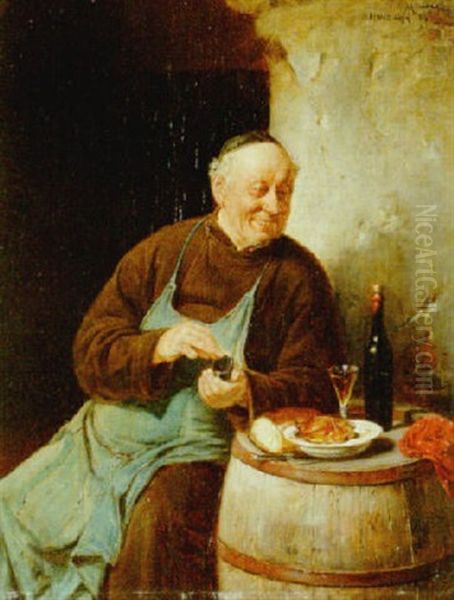
Humborg's style remained firmly rooted in the academic realism prevalent in Munich and Vienna during his formative years. His technique emphasized careful drawing, smooth finishes, and meticulous attention to detail in rendering textures, fabrics, and objects. He possessed a strong ability to model form using light and shadow (chiaroscuro), creating a sense of volume and presence for his figures and settings.
His compositions are typically well-structured and balanced, designed to clearly present the narrative or central action. Figures are arranged logically within believable spaces, often interiors illuminated by a distinct light source, such as a window or lamp, which helps to create atmosphere and focus attention.
Humborg's colour palette is often warm, favouring browns, reds, and ochres, particularly in his tavern and monastic scenes, contributing to a sense of comfort and conviviality. He demonstrated skill in capturing the play of light on different surfaces – the gleam of polished wood, the texture of rough-spun cloth, the transparency of glass, or the glint of metal.
While contemporary movements like Impressionism were emerging during Humborg's career, particularly in France and later finding adherents in Germany like Max Liebermann and Lovis Corinth, Humborg's work shows little engagement with these newer trends. He remained committed to the detailed, narrative style favoured by the academies and the established art market of his time. His art aimed for clarity, anecdote, and skillful representation rather than exploring the fleeting effects of light or subjective emotional expression in the manner of the avant-garde.
Humborg in Context: Contemporaries and Collections
Adolf Humborg worked within a rich artistic landscape. In Munich, besides the aforementioned Piloty, Diez, Grützner, and Defregger, he would have been aware of figures associated with the Academy like Wilhelm Lindenschmit the Younger, known for historical and allegorical paintings. The city was also becoming a center for Symbolism and Jugendstil towards the end of the century, with artists like Franz von Stuck gaining prominence, representing a very different artistic direction.
Humborg's connections extended beyond Munich. His origins in the Banat region and his presence in collections there highlight the artistic networks within the Austro-Hungarian Empire. Evidence mentions his work being part of a significant collection in Timișoara (Temesvár), alongside artists like Stevan Aleksić, a notable Serbian painter known for his portraits and religious works, Oskar Schuhan (possibly Oskar Schuhanek), and Endre Litteleczky. This suggests Humborg maintained ties or recognition in his broader home region.
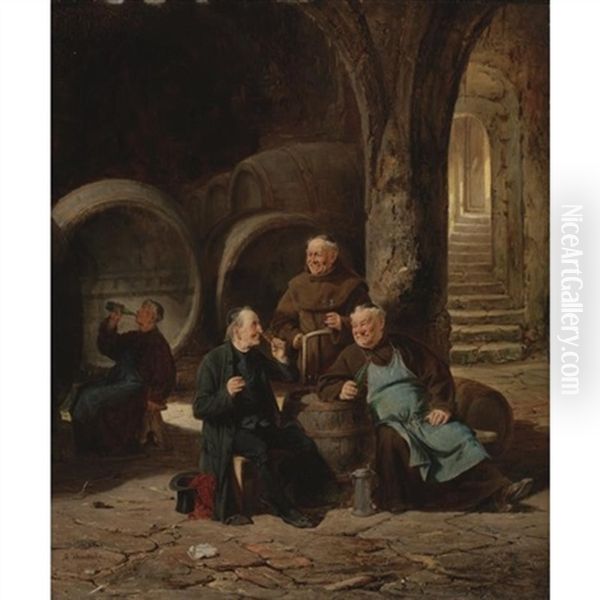
The mention of Alberto Varga alongside Humborg in collection lists is interesting, though requires careful consideration. If this refers to the famous Peruvian-American pin-up artist Alberto Vargas (1896-1982), the connection seems anachronistic. It is more likely that it refers to a different, perhaps regional, artist named Varga contemporary to Humborg, active within the Austro-Hungarian sphere. The presence of Humborg's work alongside these varied artists underscores the diverse artistic production and collecting practices within the Empire during this period.
These connections, whether through shared exhibitions, collections, or stylistic affinities, place Humborg within a specific circle of Central European artists working primarily in realistic and genre modes during the late 19th and early 20th centuries. His work represents a particular facet of this era's artistic production, one that valued narrative, craftsmanship, and relatable human moments.
Later Career and Legacy
Information about Humborg's later life suggests he continued to work productively. While Munich remained a major base, some sources indicate a possible relocation or period spent in Eisenach, Germany. Regardless of his exact location, he continued to produce the genre scenes, particularly the popular monastic subjects, for which he was known.
His works continued to find favour with collectors and were likely exhibited in the regular salon-style exhibitions common at the time. The fact that his paintings, such as Conciliabulum en réfectoire, still appear at auction houses today, sometimes commanding respectable prices, indicates a lasting appreciation for his particular brand of genre painting. These auction records confirm details like his preferred medium (oil on canvas or panel) and typical dimensions.
Adolf Humborg's legacy is that of a skilled and successful painter within the academic tradition. He masterfully catered to the tastes of his time, providing charming, well-executed glimpses into everyday life, with a special focus on the secluded world of the monastery. While he did not break new ground stylistically, he excelled within his chosen genre, creating works that continue to engage viewers with their narrative detail, gentle humour, and technical proficiency.
He represents a significant group of artists from the late 19th and early 20th centuries who maintained high standards of academic craftsmanship while adapting to the market's demand for accessible, narrative subjects. His paintings offer valuable insights into the cultural preferences and social milieu of Austria-Hungary and Southern Germany during his lifetime.
Conclusion: A Skilled Observer of Human Foibles
Adolf Humborg navigated the art world of the late Habsburg and Wilhelmine eras by perfecting a specific and popular niche. As a product of the Viennese and, more significantly, the Munich Academies, he absorbed the lessons of academic realism and applied them to genre painting. His depictions of monks, often caught in moments of mundane pleasure or minor dilemmas, became his trademark, offering audiences a blend of humour, detailed observation, and a romanticized view of cloistered life.
His representative works, including The Delayed Supper and New Wine, alongside numerous other scenes set in monasteries, taverns, and domestic interiors, showcase his consistent style: careful drawing, warm palettes, skillful rendering of textures and light, and a focus on anecdotal storytelling. He stands alongside contemporaries like Eduard von Grützner as a key practitioner of the monastic genre scene, and his work connects to the broader traditions of Munich genre painting represented by artists like Franz von Defregger and Wilhelm von Diez.
Though overshadowed by the rise of modernism, Adolf Humborg remains a noteworthy artist whose work provides a window onto the tastes and artistic currents of his time. His paintings, still appreciated in collections and at auction, testify to his enduring skill as a craftsman and his keen eye for the small, human moments that define everyday existence, whether within the walls of a monastery or a bustling Bavarian inn. He was, in essence, a talented chronicler of human nature, viewed through the lens of meticulous, charming realism.